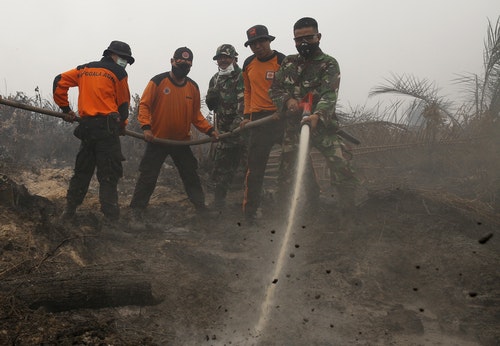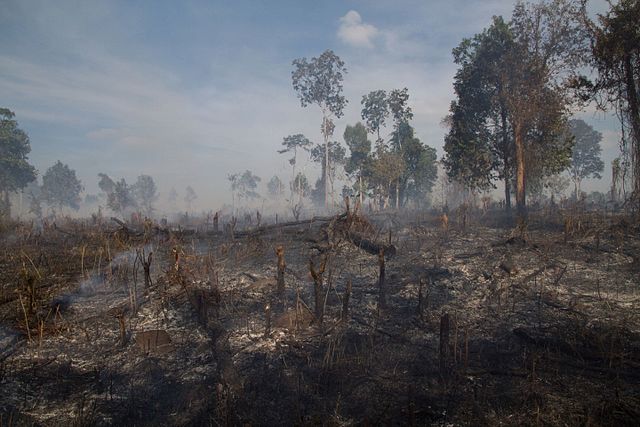Sparking debate over fire use on agricultural land in Indonesia
ANGGRITA CAHYANINGTYAS | Monday, 26 Nov 2018
New peatlands research center aims to reshape conservation efforts
Indonesia “I can keep my land fertile and I’m able to work regardless of the season, but my neighbor who uses the burning method has difficulties during the rains because their land becomes a swamp,” said Akhmad (Taman) Tamanuruddin, addressing delegates at the launch of a new peatland research center in Indonesia.
Taman is a farmer in Palangka Raya, the capital of Indonesia’s province of Central Kalimantan on the island of Borneo. He rejects the traditional local practice of using fire to clear residue from the fertile peatlands before planting his crops.
Instead, he applies herbicides and lets the old vegetation die off and decompose, allowing it to become a natural fertilizer.
Traditional burning practices are under scrutiny by scientists and policymakers because peatlands are effective carbon sinks. They are made up of layers of decomposed organic material built up over thousands of years. When they burn, warming gases are released into the atmosphere exacerbating climate change. Fires often burn out of control, damaging vast areas and drying out the land, rendering it useless for farming.
In 2015, the impact of wildfires was far-reaching. Fire destroyed more than 2.6 million hectares of land — an area 4.5 times the size of the Indonesian island of Bali, according to the World Bank. The price tag for the damage was more than $16 billion, the bank said.
Indonesia has since boosted efforts to ban the use of fire to clear forested peatlands to plant oil palms, maize or rice by establishing the Peatland Restoration Agency in 2016.
Legislation banning fire use to clear land was introduced in 2009 and 2014.
Research compiled in Riau province by Indonesia’s Forestry and Environment Research, Development and Innovation Agency (FOERDIA) of the Ministry of Environment and Forestry (MOEF) shows that land prepared by burning vegetation before planting is more productive. They examined peatlands cultivated for oil palm, rubber, corn, rice, and other food crops.
Oil palm yield in burned peatlands was found to be almost 30 percent greater than in those that were not, producing yields of about 13.3 tons per hectare a year. In peatlands that were not burned, yield was only 9.4 tons per hectare a year. Rubber tree yields were found to decrease on average by 46 percent if the land was not burned. Corn yield disparities were even more extreme.
Burning resulted in higher soil fertility in the peatlands. It also reduced acidity, contributing to the higher yields.
Aware of the yield benefits, many farmers involved in the study disregarded prohibitive legislation and burned off their fields. Of the study participants, only 49.3 percent stopped the practice, while 45.2 percent of respondents continued and 5.5 percent said they would give up on farming as they did not see any alternative to burning.
“Some farmers are unwilling to cultivate corn without burning since the yield will drop sharply and produce only a third or a quarter,” said Murniati, a scientist with FOERDIA.
“They were afraid to use the burning techniques but they don’t have enough money to finance the no-burning techniques,” Murniati added, explaining that farmers are scared of incurring penalties for violating anti-burning laws but feel they have no choice but to face the risk.
SEEKING ALTERNATIVES
Since he got involved in sustainable agriculture, Taman has trained hundreds of farmers. He adds fertile soil, dolomite, and manure to his land and plants a variety of crops, including corn, chili, and vegetables.
Initially, the cost of farming in this manner may seem more expensive, but over the long term it saves him money, Taman said, explaining the environmental benefits.
Although burning more resistant vegetation is a less expensive and easier solution, it can strip nutrient levels in the soil and spoil the peatlands in the long run.
As farmers, we need more support for infrastructure to lower costs, Taman said.
“We at least need proper roads and bridges in our village to cut distribution expenses,” he added. “It can help us big time.”
Currently, poor infrastructure causes high costs for herbicides and harvested crops. Farmers are forced to rent cars to cover a short 250-meter distance because trucks cannot fit into narrow roadways.
Finding other livelihood options might be key for helping local communities thrive while conserving peatlands, according to Dede Rohadi and Herry Purnomo, scientists with the Center for International Forestry Research (CIFOR) currently working with MOEF and several partners.
The Haze Free Sustainable Livelihoods project led by CIFOR, MOEF and the University of Lancang in Riau aims to find alternatives for farmers who cultivate crops in the province.
“We try to empower communities so they can maximize the existing livelihood potentials in their village,” said Rohadi, who leads the project.
Some villages already cultivate honey, develop fisheries and grow food crops such as chili peppers and pineapples.
In addition to the Haze-free Sustainable Livelihood project, CIFOR is currently coordinating the Community-based Fire Prevention and Peatland Restoration project with Riau University, local government, communities, and the private sector.
The latest commitment from the governments of Indonesia, the Democratic Republic of the Congo and Republic of the Congo, to establish the International Tropical Peatland Center (ITPC) promise for peatland preservation efforts. ITPC is currently based at CIFOR in Bogor, near Indonesia’s capital Jakarta.
It provides valuable opportunities for cooperation in the global south to ensure policymakers, practitioners, and communities have access to trustworthy information, analyses, and the tools needed to conserve and sustainably manage tropical peatlands.
Although peatlands extend over only 3 percent of the world’s land mass, they contain as much carbon as all terrestrial biomass and twice as much as all forest biomass.
About 15 percent of known peatlands have already been destroyed or degraded.





